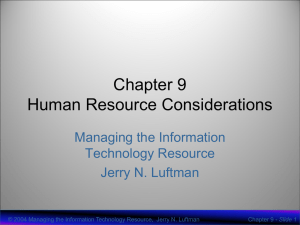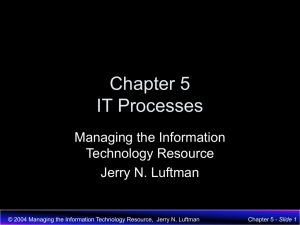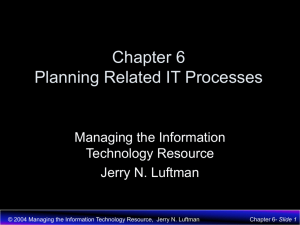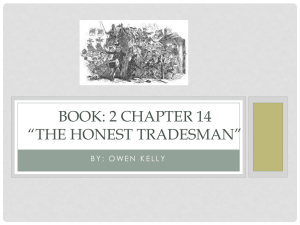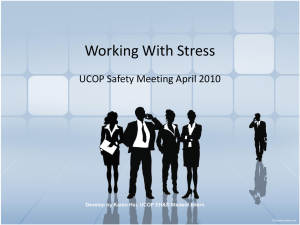Characteristics of Effective Leadership
advertisement
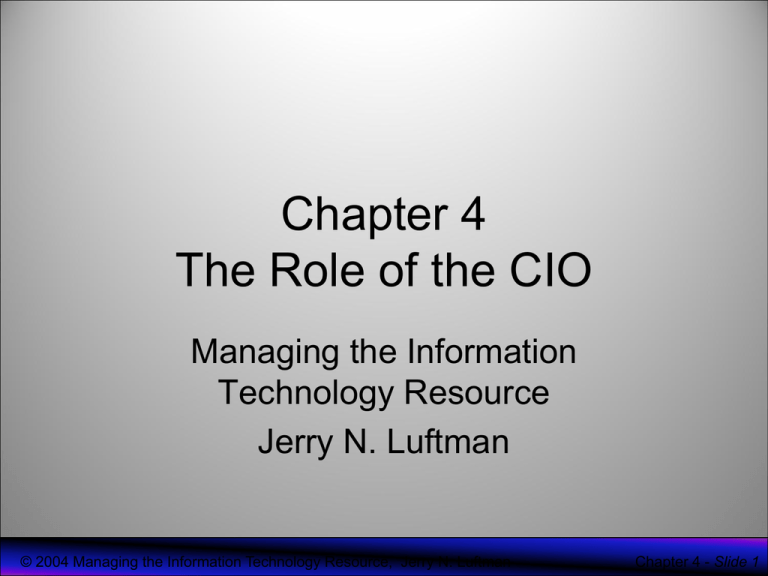
Chapter 4 The Role of the CIO Managing the Information Technology Resource Jerry N. Luftman © 2004 Managing the Information Technology Resource, Jerry N. Luftman Chapter 4 - Slide 1 Chapter Outline • • • • Role of the Chief Information Officer How role has changed over time Key characteristics of effective CIOs Relationship of the CIO to the need for alignment © 2004 Managing the Information Technology Resource, Jerry N. Luftman Chapter 4 - Slide 2 Synott’s Definition of CIO • Manage information resources as vital corporate asset • Bring systems into competitive marketplace • Manage and coordinate increasingly decentralized information resources • Manage end-user computing so that it serves corporation's needs • Be a catalyst for corporate change © 2004 Managing the Information Technology Resource, Jerry N. Luftman Chapter 4 - Slide 3 Evolution of CIO • Term coined in 1980s and continues to change over time • Viewed as a strategist, not a manager • Leadership is key • Influence of CIO on forces determines effectiveness of CIO © 2004 Managing the Information Technology Resource, Jerry N. Luftman Chapter 4 - Slide 4 © 2004 Managing the Information Technology Resource, Jerry N. Luftman Chapter 4 - Slide 5 Distributed Era of CIO Roles • Four Roles Emerged from Distributed Era – Organizational Designer – Strategic Partner – Technology Architect – Informed Buyer © 2004 Managing the Information Technology Resource, Jerry N. Luftman Chapter 4 - Slide 6 Web-Based Era • CIO has new responsibilties • Role includes suppliers and customers • New roles are added to CIO © 2004 Managing the Information Technology Resource, Jerry N. Luftman Chapter 4 - Slide 7 CIO’s Resume Today • • • • • • • • Knowledge of applying IT to business Visionary leader Relationship manager Marketer Open systems-oriented 20 years in LOB management jobs French, German, Japanese Masters, Harvard Business © 2004 Managing the Information Technology Resource, Jerry N. Luftman Chapter 4 - Slide 8 © 2004 Managing the Information Technology Resource, Jerry N. Luftman Chapter 4 - Slide 9 Current View of the CIO • • • • • • Highly mobile – high turnover Must deliver effectively and rapidly Well-rounded Technically astute People-oriented Business skills © 2004 Managing the Information Technology Resource, Jerry N. Luftman Chapter 4 - Slide 10 Concerns of CIOs • • • • • • • • 94% Enhancing customer satisfaction 92% Security 89% Technology evaluation 87% Budgeting 83% Staffing 66% ROI analysis 64% Building new equipment 45% Outsourcing hosting © 2004 Managing the Information Technology Resource, Jerry N. Luftman Chapter 4 - Slide 11 © 2004 Managing the Information Technology Resource, Jerry N. Luftman Chapter 4 - Slide 12 © 2004 Managing the Information Technology Resource, Jerry N. Luftman Chapter 4 - Slide 13 How CIO Affects Value of IT • Focus on business needs as they relate to IT organization • Educator to business executives • Demonstrate importance of IT • Foster greater interaction • Communicate successes and value of IT • Good understanding of business vision © 2004 Managing the Information Technology Resource, Jerry N. Luftman Chapter 4 - Slide 14 Global CIO • Must deal with factors from other nations • Education and experience in dealing with people of other nationalities and cultures • Knowledgeable about cultural differences • Knowledgeable about geography and history • Effectively deal with language differences © 2004 Managing the Information Technology Resource, Jerry N. Luftman Chapter 4 - Slide 15 CIO Attributes – Analyst background and orientation – Promote IT as agent of business transformation – Contributes beyond IT function – Accurate perception of CEO views on business and IT – Integrates IT with business planning – Profile stresses consultative leadership and creativity © 2004 Managing the Information Technology Resource, Jerry N. Luftman Chapter 4 - Slide 16 CEO Attributes • General management and/or marketing background • Change-oriented leadership • Attended IT “awareness” seminars • Experience IT project success • Perceives IT as critical to the business • Positions IT as agent of business transformation © 2004 Managing the Information Technology Resource, Jerry N. Luftman Chapter 4 - Slide 17 Organizational Attributes • Personal/informal executive style • Executive workshops on strategic issues • CIO accepted in executive team © 2004 Managing the Information Technology Resource, Jerry N. Luftman Chapter 4 - Slide 18 CEO Fit for Information Age © 2004 Managing the Information Technology Resource, Jerry N. Luftman Chapter 4 - Slide 19 CEO Must Believe in IT Importance • Creating context • Setting priorities • Signaling continuously and positively • Spending quality time • Relating with CIO • Scan and understand new technologies • Working on vision of the Future • Sponsoring internal and external architectures • Embedding information management processes • Challenging IT’s supply side © 2004 Managing the Information Technology Resource, Jerry N. Luftman Chapter 4 - Slide 20 Top 10 CIO Requirements 1. Leadership 2. Expertise in aligning and leveraging 3. Business savvy 4. Relationship skills 5. Management skills 6. Communication skills 7. Ability to create and manage change 8. Knowledge and experience in specific industry 9. International experience 10.Ability to hire, develop, and retain quality IT professionals © 2004 Managing the Information Technology Resource, Jerry N. Luftman Chapter 4 - Slide 21 The Effective CIO • • • • Delegation of Operational Tasks Seize Expenditure/Financial Authority Avoid Adversarial Positions Initiate Contacts Outside the Information Technology Unit – Create relationships with business peers • Use Language Carefully – Avoid use of technology jargon © 2004 Managing the Information Technology Resource, Jerry N. Luftman Chapter 4 - Slide 22 Feeny’s Characteristics of “Ideal” CIO • Honesty, Integrity, Sincerity, Openness • Business Perspective, Motivation, Language • Communicator, Educator, Motivator, Leader, Politician, Relationship Builder • Continuously Informed on Developments in IT, Able to Interpret their Significance to Business • Change-Oriented Team Play, Catalyst to Business Thinking © 2004 Managing the Information Technology Resource, Jerry N. Luftman Chapter 4 - Slide 23 IT Managerial Skill Mix © 2004 Managing the Information Technology Resource, Jerry N. Luftman Chapter 4 - Slide 24 What Makes a Manager? • Information Processing Roles – Disseminator • Interpret and edit before passing along – Monitor • Analyze information available to ascertain problems • Stay informed of activities outside subunit – Spokesperson • Source of information about subunit • Sell capabilities and value of organization © 2004 Managing the Information Technology Resource, Jerry N. Luftman Chapter 4 - Slide 25 What Makes a Manager? • Decision-Making Roles – Entrepreneur • Ability to change design of unit structure – Disturbance Handler • Deal with conflict and crises – Resource Allocator • Control resources with organization – Negotiator • Negotiate commitments © 2004 Managing the Information Technology Resource, Jerry N. Luftman Chapter 4 - Slide 26 What Makes a Manager? • Interpersonal Roles – Liaison • Maintain relationships with other units – Figurehead –Formal obligations that come with managerial title – Leader • Includes human resources activities © 2004 Managing the Information Technology Resource, Jerry N. Luftman Chapter 4 - Slide 27 What Makes a Leader? • Broad business and organizational knowledge • Broad set of relationships in firm and industry • Excellent reputation and strong track record • Keen mind and strong interpersonal skills • High integrity and personal values • High level of motivation © 2004 Managing the Information Technology Resource, Jerry N. Luftman Chapter 4 - Slide 28 Characteristics of Effective Leadership • • • • • • • • • Has willing followers Relationship between leaders and followers Leadership occurs as an event Use influence beyond formal authority Operate outside boundaries of defined procedures Involves risks and uncertainty Not everyone will follow leader’s initiative Consciousness creates leadership Is a self-referral process © 2004 Managing the Information Technology Resource, Jerry N. Luftman Chapter 4 - Slide 29 Leaders vs. Managers © 2004 Managing the Information Technology Resource, Jerry N. Luftman Chapter 4 - Slide 30 Organizational Role Changes of CIO • Networking resources to exchange information • Share data elements among business units/external firms • Apply common application systems across the firm • Requirements for specialized IT human resources © 2004 Managing the Information Technology Resource, Jerry N. Luftman Chapter 4 - Slide 31 Critical IT Management Processes • • • • • Setting strategic direction Establishing infrastructure systems Scanning technology Transferring technology Developing business systems © 2004 Managing the Information Technology Resource, Jerry N. Luftman Chapter 4 - Slide 32 Functional Changes in Role of CIO • Focus on Strategist role • At the center of operations for strategy pertaining to technology • Implementation of strategies pertaining to technology • Technology executive acting as counselor to business executives © 2004 Managing the Information Technology Resource, Jerry N. Luftman Chapter 4 - Slide 33 Tips for New CIO • • • • • • • Get a seat at the table One-to-one communications with CEO Partnership with peers Study corporate culture Understand business model Define current commitments Establish credibility through small things © 2004 Managing the Information Technology Resource, Jerry N. Luftman Chapter 4 - Slide 34 Tips for New CIO • • • • • • • Build personal board of directors Listen and talk Be accessible and responsive Set realistic goals Take inventory Assess your people Understand value and threat of outsourcing © 2004 Managing the Information Technology Resource, Jerry N. Luftman Chapter 4 - Slide 35
